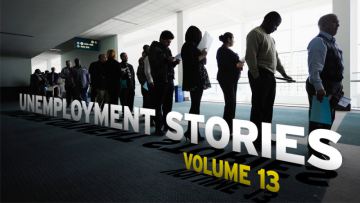The ‘bad luck’ theory of unemployment As is well-known, New Classical Economists have never accepted Keynes’s distinction between voluntary and involuntary unemployment. According to New Classical übereconomist Robert Lucas, an unemployed worker can always instantaneously find some job. No matter how miserable the work options are, “one can always choose to accept them,” according to Lucas: KLAMER: My taxi driver here is driving a taxi, even though he is an accountant, because he can’t find a job … LUCAS: I would describe him as a taxi driver [laughing], if what he is doing is driving a taxi. KLAMER: But a frustrated taxi driver. LUCAS: Well, we draw these things out of urns, and sometimes we get good draws, sometimes we get bad draws. Arjo Klamer In New Classical Economics unemployment is seen as as a kind of leisure that workers optimally select. This is, of course, only what you would expect of New Classical Chicago economists. But sadly enough this extraterrestial view of unemployment is actually shared by so called New Keynesians, whose microfounded dynamic stochastic general equilibrium models cannot even incorporate such a basic fact of reality as involuntary unemployment! Of course, working with microfounded representative agent models, this should come as no surprise. If one representative agent is employed, all representative agents are.
Topics:
Lars Pålsson Syll considers the following as important: Economics
This could be interesting, too:
Lars Pålsson Syll writes Schuldenbremse bye bye
Lars Pålsson Syll writes What’s wrong with economics — a primer
Lars Pålsson Syll writes Krigskeynesianismens återkomst
Lars Pålsson Syll writes Finding Eigenvalues and Eigenvectors (student stuff)
 As is well-known, New Classical Economists have never accepted Keynes’s distinction between voluntary and involuntary unemployment. According to New Classical übereconomist Robert Lucas, an unemployed worker can always instantaneously find some job. No matter how miserable the work options are, “one can always choose to accept them,” according to Lucas:
As is well-known, New Classical Economists have never accepted Keynes’s distinction between voluntary and involuntary unemployment. According to New Classical übereconomist Robert Lucas, an unemployed worker can always instantaneously find some job. No matter how miserable the work options are, “one can always choose to accept them,” according to Lucas:
KLAMER: My taxi driver here is driving a taxi, even though he is an accountant, because he can’t find a job …
LUCAS: I would describe him as a taxi driver [laughing], if what he is doing is driving a taxi.
KLAMER: But a frustrated taxi driver.
LUCAS: Well, we draw these things out of urns, and sometimes we get good draws, sometimes we get bad draws.
In New Classical Economics unemployment is seen as as a kind of leisure that workers optimally select.
This is, of course, only what you would expect of New Classical Chicago economists.
But sadly enough this extraterrestial view of unemployment is actually shared by so called New Keynesians, whose microfounded dynamic stochastic general equilibrium models cannot even incorporate such a basic fact of reality as involuntary unemployment!
Of course, working with microfounded representative agent models, this should come as no surprise. If one representative agent is employed, all representative agents are. The kind of unemployment that occurs is voluntary, since it is only adjustments of the hours of work that these optimizing agents make to maximize their utility.
In the basic DSGE models used by most ‘New Keynesians’, the labour market is always cleared – responding to a changing interest rate, expected life time incomes, or real wages, the representative agent maximizes the utility function by varying her labour supply, money holding and consumption over time. Most importantly – if the real wage somehow deviates from its “equilibrium value,” the representative agent adjust her labour supply, so that when the real wage is higher than its “equilibrium value,” labour supply is increased, and when the real wage is below its “equilibrium value,” labour supply is decreased.
In this model world, unemployment is always an optimal choice to changes in the labour market conditions. Hence, unemployment is totally voluntary. To be unemployed is something one optimally chooses to be.
It is extremely important to pose the question why mainstream economists choose to work with these kinds of models. It is not a harmless choice based solely on ‘internal’ scientific considerations. It is in fact also, and not to a trivial extent, a conscious choice motivated by ideology.
By employing these models one is actually to a significant degree absolving the structure of market economies from any responsibility in creating unemployment. Focussing on the choices of individuals, the unemployment ‘problem’ is reduced to being an individual ‘problem’, and not something that essentially has to do with the workings of market economies. A conscious methodological choice in this way comes to work as an apologetic device for not addressing or challenging given structures.
Not being able to explain unemployment, these models can’t help us to change the structures and institutions that produce the arguably greatest problem of our society.
